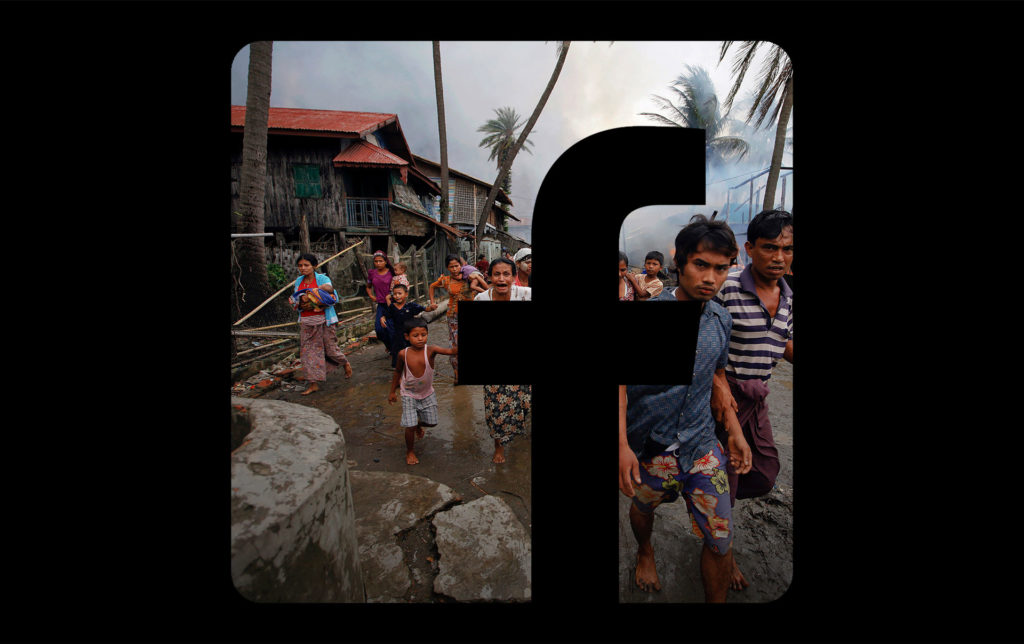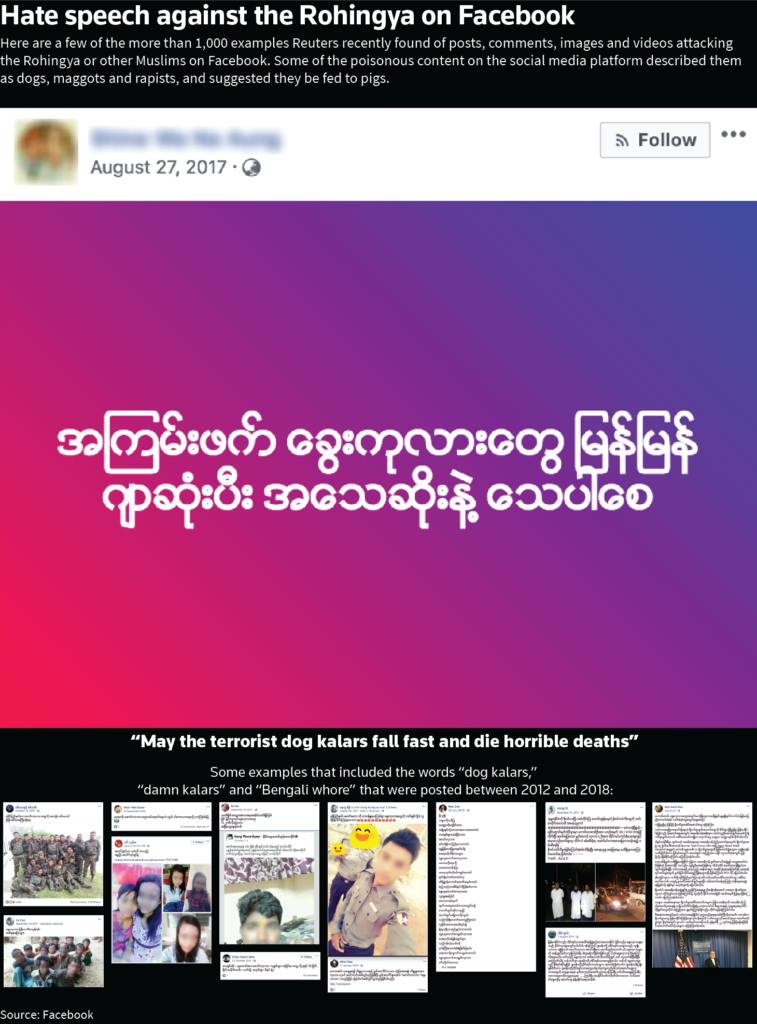Inside Facebook’s Myanmar Operation: Hatebook
INDIGENOUS RIGHTS, HUMAN RIGHTS, ASIA--PACIFIC, ASIA-UPDATES ON MYANMAR ROHINGYA GENOCIDE, MEDIA, WHISTLEBLOWING - SURVEILLANCE, 20 Aug 2018
Steve Stecklow | Reuters – TRANSCEND Media Service
A Reuters Special Report – Hatebook

ETHNIC VIOLENCE: There have been repeated outbreaks of communal violence in Myanmar. In March, a United Nations investigator said Facebook had been used to incite hatred against the Rohingya.
REUTERS/Soe Zeya Tun
Why Facebook Is Losing the War on Hate Speech in Myanmar
Reuters found more than 1,000 examples of posts, comments and pornographic images attacking the Rohingya and other Muslims on Facebook. A secretive operation set up by the social media giant to combat the hate speech is failing to end the problem.
15 Aug 2018 – In April, Facebook founder Mark Zuckerberg told U.S. senators that the social media site was hiring dozens more Burmese speakers to review hate speech posted in Myanmar. The situation was dire.
Some 700,000 members of the Rohingya community had recently fled the country amid a military crackdown and ethnic violence. In March, a United Nations investigator said Facebook was used to incite violence and hatred against the Muslim minority group. The platform, she said, had “turned into a beast.”
Four months after Zuckerberg’s pledge to act, here is a sampling of posts from Myanmar that were viewable this month on Facebook:
One user posted a restaurant advertisement featuring Rohingya-style food. “We must fight them the way Hitler did the Jews, damn kalars!” the person wrote, using a pejorative for the Rohingya. That post went up in December 2013.
Another post showed a news article from an army-controlled publication about attacks on police stations by Rohingya militants. “These non-human kalar dogs, the Bengalis, are killing and destroying our land, our water and our ethnic people,” the user wrote. “We need to destroy their race.” That post went up last September, as the violence against the Rohingya peaked.
A third user shared a blog item that pictures a boatload of Rohingya refugees landing in Indonesia. “Pour fuel and set fire so that they can meet Allah faster,” a commenter wrote. The post appeared 11 days after Zuckerberg’s Senate testimony.
The remarks are among more than 1,000 examples Reuters found of posts, comments, images and videos attacking the Rohingya or other Myanmar Muslims that were on Facebook as of last week. Almost all are in the main local language, Burmese. The anti-Rohingya and anti-Muslim invective analyzed for this article – which was collected by Reuters and the Human Rights Center at UC Berkeley School of Law – includes material that’s been up on Facebook for as long as six years.
The poisonous posts call the Rohingya or other Muslims dogs, maggots and rapists, suggest they be fed to pigs, and urge they be shot or exterminated. The material also includes crudely pornographic anti-Muslim images. The company’s rules specifically prohibit attacking ethnic groups with “violent or dehumanising speech” or comparing them to animals. Facebook also has long had a strict policy against pornographic content.
The use of Facebook to spread hate speech against the Rohingya in the Buddhist-majority country has been widely reported by the U.N. and others. Now, a Reuters investigation gives an inside look at why the company has failed to stop the problem.
For years, Facebook – which reported net income of $15.9 billion in 2017 – devoted scant resources to combat hate speech in Myanmar, a market it dominates and in which there have been regular outbreaks of ethnic violence. In early 2015, there were only two people at Facebook who could speak Burmese reviewing problematic posts. Before that, most of the people reviewing Burmese content spoke English.
To continue reading the report Go to Original – reuters.com
DISCLAIMER: The statements, views and opinions expressed in pieces republished here are solely those of the authors and do not necessarily represent those of TMS. In accordance with title 17 U.S.C. section 107, this material is distributed without profit to those who have expressed a prior interest in receiving the included information for research and educational purposes. TMS has no affiliation whatsoever with the originator of this article nor is TMS endorsed or sponsored by the originator. “GO TO ORIGINAL” links are provided as a convenience to our readers and allow for verification of authenticity. However, as originating pages are often updated by their originating host sites, the versions posted may not match the versions our readers view when clicking the “GO TO ORIGINAL” links. This site contains copyrighted material the use of which has not always been specifically authorized by the copyright owner. We are making such material available in our efforts to advance understanding of environmental, political, human rights, economic, democracy, scientific, and social justice issues, etc. We believe this constitutes a ‘fair use’ of any such copyrighted material as provided for in section 107 of the US Copyright Law. In accordance with Title 17 U.S.C. Section 107, the material on this site is distributed without profit to those who have expressed a prior interest in receiving the included information for research and educational purposes. For more information go to: http://www.law.cornell.edu/uscode/17/107.shtml. If you wish to use copyrighted material from this site for purposes of your own that go beyond ‘fair use’, you must obtain permission from the copyright owner.
Read more
Click here to go to the current weekly digest or pick another article:
INDIGENOUS RIGHTS:
- We Must Purge Genocide from the Marrow of Our Bones
- The Day of the World’s Indigenous Peoples
- ‘A World without Borders’: Revolutionary Love and Solidarity for Palestine
HUMAN RIGHTS:
- US “Relocates” Iraqi Refugee to Rwanda via New Diplomatic Arrangement
- How the Human Rights Industry Manufactures Consent for “Regime Change”
- Genocide Emergency: Gaza and the West Bank 2024
ASIA--PACIFIC:
- Nepal: Proto-Nationalism Entrapped in the Musical Chair Circle of Political Parties and Floundering Economy
- South Korea's Biosecurity Is Safe, Thanks to Russia
- India and Pakistan: Freedom Lost but Animosity Flourishes
ASIA-UPDATES ON MYANMAR ROHINGYA GENOCIDE:
- India Must End Arbitrary Arrest, Detention, and Forced Returns of Rohingya Refugees
- Myanmar’s War Has Forced Doctors and Nurses into Prostitution
- Six Years After Their Darkest Hour, the Rohingya Have Been Abandoned
MEDIA:
- The Media Calls Israeli Captives “Hostages” and Palestinians “Prisoners”
- The Media Navigator (2025)
- Zuckerberg and Musk Have Shown that Big Tech Doesn’t Care about Facts
WHISTLEBLOWING - SURVEILLANCE:
